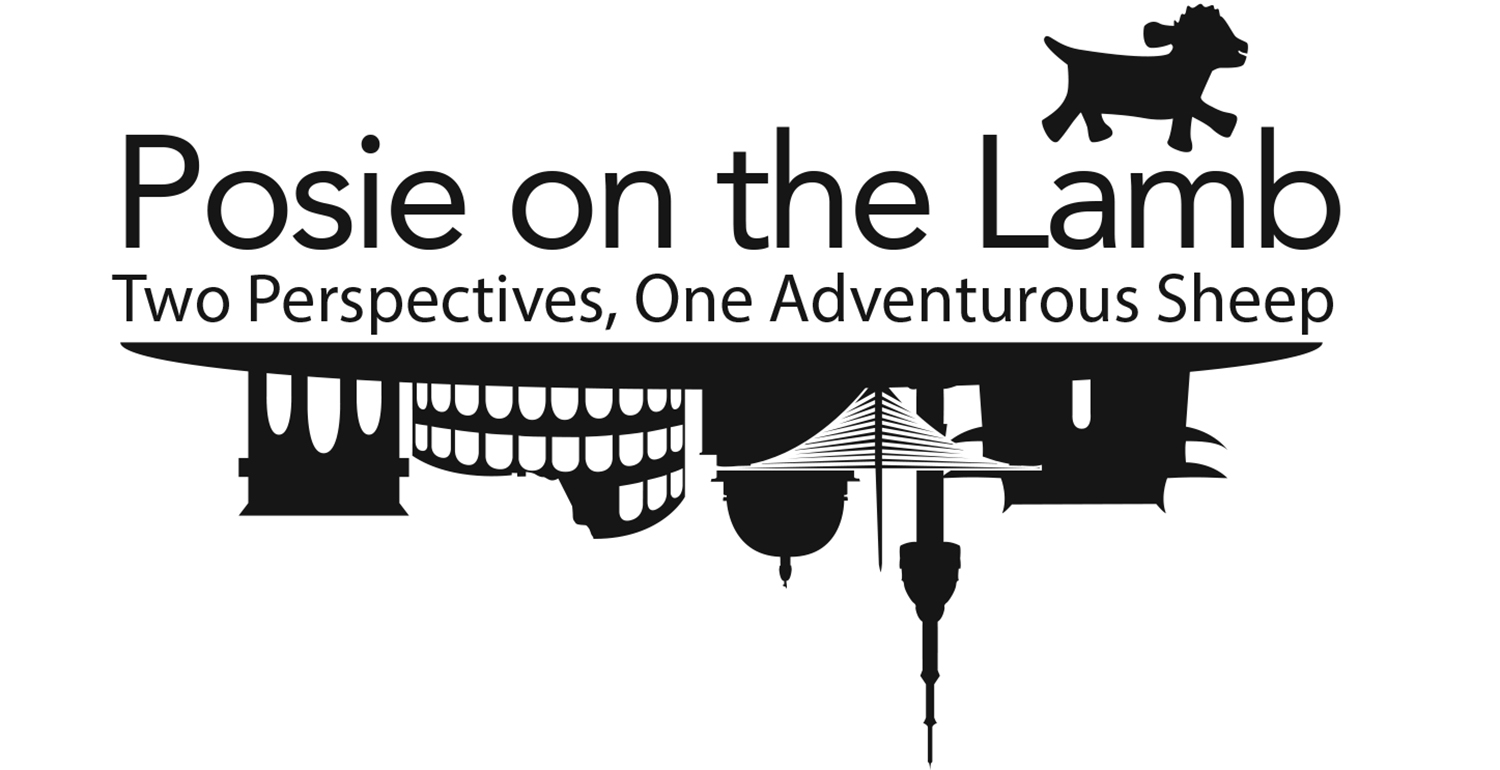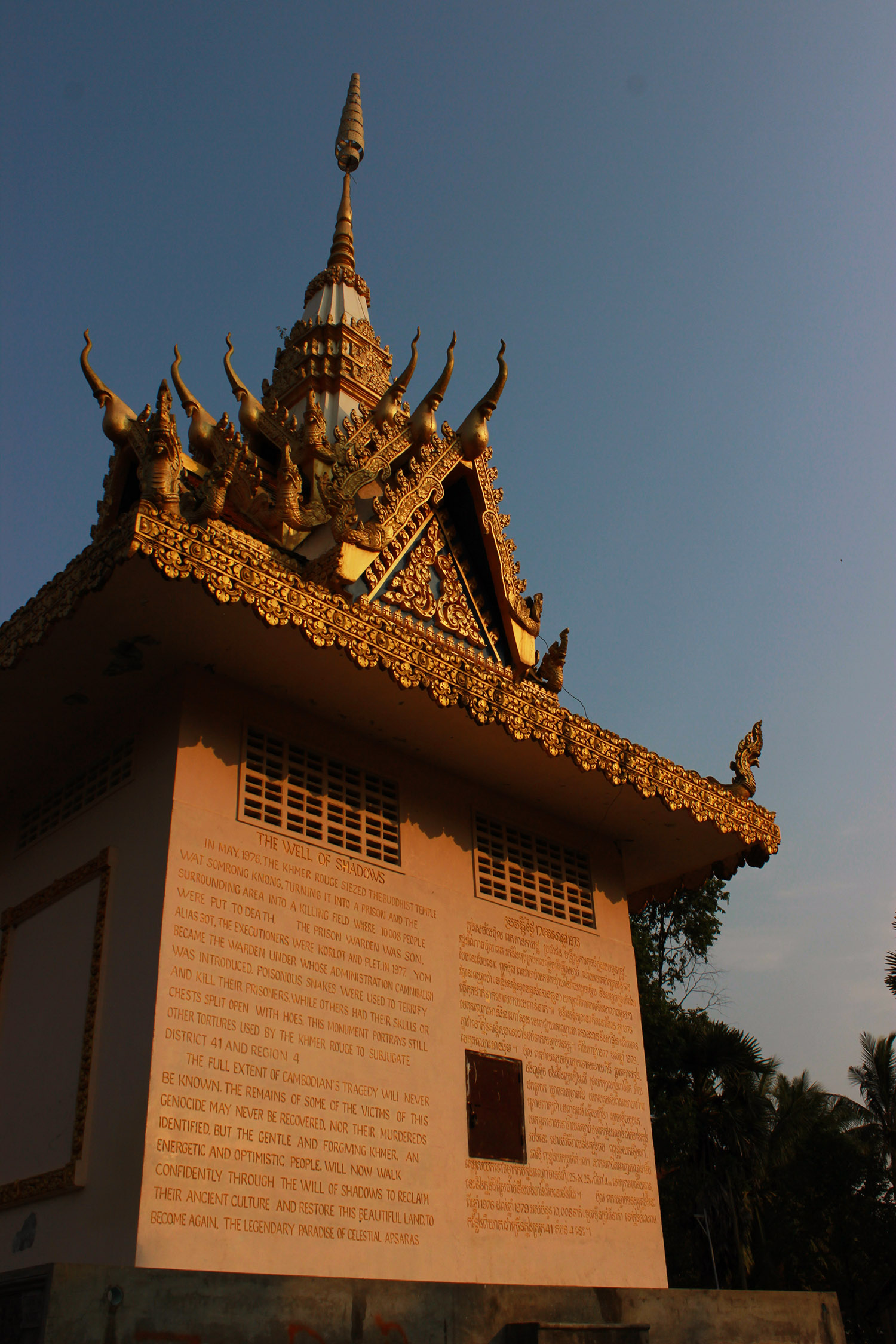A Place of Nightmares

I’m sitting across from a Cambodian George Clooney, a man far too handsome for his age.
He’s dressed in a faded Hawaiian shirt and wears his silvery hair in a deep side part. His eyes crinkle when he smiles at me. I smile back, wringing my pen with nervous fingers. It’s nearly a hundred degrees, but I’m soaked with anxiety as much as the heat. I’ve had an hour waiting in the sun to contemplate what a seriously bad idea this is.
Mr. Clooney—Mr. Chhan, really—waits patiently as my eyes flit between him and the questions scrawled in my notebook. Over his shoulder I see two men watching me. One works at the monastery’s tiny museum; the other is a statue in a flat, black cap. Neither looks pleased. The statue wields a hoe, recalling a famous saying from the 1970s: when pulling out weeds, remove them roots and all.
Just beyond the monastery walls are the effects of that philosophy: a shrine, prickly with human bones. It marks a Killing Field, where cadres of the Khmer Rouge bludgeoned locals to death with farm implements. Then they eliminated their victims’ “roots”—parents, spouses, children—to prevent regrowth.
I’d asked to interview a survivor of that atrocity. Now that I’m here, I can’t figure out how to start. Hi there. I hear you lived through the torture, murder, occasional dismemberment, and partial devouring of everyone around you. So, what was that like?
The museum employee glares from the doorway. My translator advises I ask my questions. “But I think you should be very quick.”
***
Cambodia has two main claims to fame: Angkor Wat and genocide. As National Geographic notes, both really bring in the tourists.
The Khmer Rouge took control of Cambodia in 1975, after five years of civil war. Lead by a moon-faced fanatic called Pol Pot, they systematically disassembled the country in order to remodel it on fictionalized Good Old Days, without the corrupting influences of ownership, marriage, literacy, or compassion. Their reign could be counted in years (4), mass grave sites (nearly 20,000), or deaths (at least 1.7 million, maybe as many as 3 million). Practically every Cambodian older than me is a survivor.
Before we visited Cambodia last month, I contacted a translator to help arrange interviews for a travel article I was writing. And I threw in an extra request, just a side project I’d been toying with, about the similarities between the Khmer Rouge and the so-called Islamic State.
“If possible, I’d also like to talk to people who remember the Pol Pot times.” I asked.
“Yes, I can help you with that,” my translator agreed readily.
Of course, it wasn’t really that simple. Since I didn’t have an actual assignment for the piece and wasn’t open to buying interviews (“But Erin, when Cambodian people talk to a foreigner, they expect some tip”), my translator took us to a monastery, where someone might speak to me as an act of charity.
Somroung Khong Monastery, like many Buddhist sites, was used as a prison by the Khmer Rouge. Pol Pot wasn’t so keen on religion (or anything else that might deflect the people’s faith from himself). Prisoners were chained en masse to the floor and interrogated in a tiny building near a gap in the monastery walls. After being tortured into signing “confessions,” they were hauled through the gap to die in the field beyond. Over 10,000 bodies were found there.
In the early 2000s, a shrine called the Well of Shadows was erected in the center of the field. The Somroung Khong Community Peace Learning Center was established to preserve the site and educate people about the genocide. The torture chamber became a museum. Mr. Chhan volunteers there, gathering information for the Learning Center and teaching young Cambodians about the darkness their parents and grandparents passed through.
We tend to give top marks to Nazis when it comes to the organized slaughter of innocents. But the Khmer Rouge, it has to be said, really got things done. When they took control of Cambodia in 1975, they didn’t just cart away the unmentionables. Everyone went—all cities were cleared out—as they moved the entire population to the countryside to live out the Agrarian Dream. The calendar was reset at year zero, and everyone was instructed to grow rice and be as stupid as possible.
I’m not being facetious. Education was actively discouraged. The Khmer Rouge killed anyone who even looked educated. That included people who had university degrees, or spoke foreign languages (a real bummer, since Cambodia had been a French colony just twenty years earlier), or wore glasses, or knew which part of a stethoscope to put in their ears. And, of course, their roots.*
As for growing rice, well, that went as well as could be expected if you plunked a bunch of lawyers, janitors, artists, and washing machine repairmen down in a field and told them to grow three times as much food as a farmer ever could.
When the Khmer Rouge took power, Mr. Chhan was newly married and fresh from university, two strikes already. And then he began hearing stories of murdered classmates. As a way to survive, he volunteered to work as a lumberjack in eastern Cambodia, where no one would know him. He leapfrogged around the country, staying just ahead of discovery. Officials often tested him on suspicion of being educated. He wrote the answers left-handed, peppering his labored writing with deliberate mistakes.
He tells me all this — about the daring rescue of his wife, his life-saving ability to repair tractor engines, how he finally returned home to a family who’d long ago mourned his death—with a lovely smile, as though telling me about his grandkids.
“Before the Khmer Rouge time,” I venture, “The United States dropped a lot of bombs on Cambodia. Did that affect you?”
My translator relays this question. It’s the only time Mr. Chhan does not smile.
His answer is long, but the translation I’m given is short. “The US and Khmer pilots both dropped bombs at that time. Sometimes, they made mistakes.”
***
As an American, I tend to view my country through WWII-tinted lenses, when we were super-awesome heroes who helped end a horrifying genocide. But that doesn’t work here. The US bombed the hell out of Cambodia. Then they lied about it. It had nothing to do with stopping the Khmer Rouge.**
Bomb-raids started secretly in 1965 (though as far as the American public knew, they began in 1969—the actual date was only revealed in 2000), in an attempt to destroy the Viet Cong’s illicit supply routes in eastern Cambodia. Over the years, the raids pushed steadily across the country, essentially a long-term carpet-bombing campaign. Cambodia was a neutral neighbor to the Vietnam-American war, yet the bombing there outstripped the total of explosives dropped by the Allies in WWII.
“In the US, bombing in Cambodia was called the Secret War,” we were told at the Genocide Museum in Phnom Penh a few days later. “It was no secret here.”
The raids were quite helpful to an emerging rebel group called the Khmer Rouge. After a bombing, KR soldiers would visit the decimated villages to recruit among the survivors who, up until recently, hadn’t cared one way or the other about the United States.
“The Khmer Rouge were a force of 5,000 people when the heaviest part of the bombing began,” noted Dr. Taylor Owen at the International Conference of Crisis Mappers in 2012. “Three years later, they were a force of 200,000, capable of taking over a US-backed government.”
When the Khmer Rouge marched into Phnom Penh on April 17, 1975, the people thought they were bring liberated. After years of civil war and being blown up by flying strangers, they thought this was the end of their troubles.
Within hours, the Khmer Rouge began emptying the city.
***
“You’ve just entered a place of nightmares.”
The Tuol Sleng Genocide Museum pulls no punches. It was once the Khmer Rouge’s most notorious prison, known as S-21. Now it’s a memorial, with rooms preserved as they were found, and photographic evidence presented on the walls.
On top of their crimes against humanity, the Khmer Rouge officers were officious little bureaucrats. Every prisoner who came in to S-21 was meticulously photographed and catalogued. Years after, Cambodians came to search among the black and white still frames for missing family members. Now, travelers come from around the world to try and understand the tragedy.
The museum has an excellent and truly disturbing audio tour. Visitors can rent earphones for a more-or-less private experience. I move slowly through; the voices in my head describe the people who died where I stand. Occasionally, I step outside to sit on a bench among the blooming frangipani trees, still standing from the buildings’ original days as a high school. The P.E. equipment is still there too—the Khmer Rouge converted the climbing ropes and chin-up bars into torture devices.
At least 12,000 people were sent to Tuol Sleng—though the actual number could be nearly twice as high. Only twelve prisoners lived to describe it. Statistically, you’d have had better odds in Auschwitz.
The museum displays photos of the captors too, indistinguishable from their prisoners save that the bad guys wore hats. Indeed, many became victims as the Khmer Rouge devolved into paranoia and collapsed in on itself. The scariest thing about them was their age. The grunt work of Pol Pot’s killing machine was executed by teenagers, children trained to feel nothing toward their victims.
***
There’s a gift stand at the end of the Tuol Sleng tour. Beyond it, two Khmer Rouge survivors snooze lightly amid stacks of their memoirs. I consider sliding onto the chair across from them, asking some questions, buying a book. Instead, I move past the browsing, sunburned shoppers to the exit.
Several survivors have written books about their experiences under the Khmer Rouge. Perhaps the most famous is Loung Uon’s First They Killed My Father. Angelina Jolie is adapting it as a movie, and was recently in Cambodia for filming. I happened to visit an arts school that supplied extras for the cast, and they were thrilled to tell me all about it. (Though even they think Angelina’s too skinny.)
Frankly, a movie by Angelina Jolie will probably do more toward the Genocide Museum’s mission than it can achieve itself. As the audio-guide puts it, the museum wants the story of S-21 to be “remembered for generations, so it will never happen again.”
I wonder how many shrines and memorials around the world use those same words. Yet human memory doesn’t retain clarity like the sentiments we carve in stone. This thought feels hopeless, but there’s a kindness in it too. It’s the softening of memory that lets us recover from tragedy, move past it, plant new roots, regrow.
The sweetness of forgetting came home to me after I shook Mr. Chhan’s hand goodbye at Somroung Khong. Sam was waiting by the Killing Fields, where he had taken pictures of the Well of Shadows in the orange, evening light.
“Sorry I couldn’t get better photos,” he apologized as we left. “There were kids playing in the grass in front of the shrine.”
-Erin
*These treasons didn’t affect the careers of Sun Sen, Pol Pot’s bespectacled Minister of National Defense, or Duch, the commander of Tuol Sleng prison and one-time mathematics professor.
**It was Vietnam that liberated Cambodians from the Khmer Rouge in 1979.

